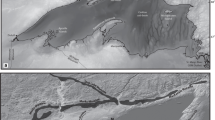Abstract
Radiocarbon and uranium-series ages of a variety of materials from the Lahontan basin indicate that the last highstand lake occurred between 14 500 and 13 000 yr B.P. Although few in number, existing radiocarbon and uranium-series age data also indicate that lakes in the western Lahontan subbasins were small or moderate in size between 30 000 and 25 000 yr B.P. Existing data do not support the conclusions of Bradbury et al. (1989) who did not find evidence of a 14 000±yr B.P. highstand lake in the sediments of the Walker Lake subbasin. These data also do not support the existence of a highstand lake in the Walker Lake subbasin between 30 000 and 25 000 yr B.P.
Similar content being viewed by others
References
Benson, L. V., 1978. Fluctuation in the level of pluvial Lake Lahontan during the last 40 000 years. Quat. Res. 9: 300–318.
Benson, L. V., 1981. Paleoclimatic significance of lake-level fluctuations in the Lahontan Basin. Quat. Res. 16: 390–403.
Benson, L. V., 1988. Preliminary paleolimnologic data for the Walker Lake subbasin, California and Nevada: U.S. Geological Survey Water-Resources Investigation Report 87-4258, 50 pp.
Benson, L. V., 1989. Guidebook for a field tour of the Lake Lahontan basin. In G. I. Smith (ed.), Quaternary geology of the Great Basin, IGC Trip Guidebook T 117: 38–55.
Benson, L. V. & R. S. Thompson, 1987a. Lake-level variation in the Lahontan Basin for the past 50 000 years. Quat. Res. 28: 69–85.
Benson, L. V. & R. S. Thompson, 1987b. The physical record of lakes in the Great Basin. In W. F. Ruddiman & H. E. WrightJr. (eds.), North America and adjacent oceans during the last deglaciation, vol. K-3, Geol. Soc. Am., Boulder, Colo., The Geology of North America: 241–260.
Benson, L. V., D. R. Currey, R. I. Dorn, K. R. Lajoie, C. G. Oviatt, S. W. Robinson, G. I. Smith & S. Stine, 1990. Chronology of expansion and contraction of four Great Basin lake systems during the past 35 000 years. In P. A. Meyers & L. V. Benson (eds.), Paleolakes and Paleooceans. Palaeogeogr. Palaeoclim. Palaeoecol. 78: 241–286.
Bradbury, J. P., R. M. Forester & R. S. Thompson, 1989. Late Quaternary paleolimnology of Walker Lake, Nevada. J. Paleolim. 1: 249–267.
Broecker, W. S. & P. C. Orr, 1958. Radiocarbon chronology of Lake Lahontan and Lake Bonneville. Geol. Soc. Am. Bull. 69: 1009–1032.
Cahill, T. A. & T. E. Gill, 1987. Air quality at Mono Lake. Report to the Community and Organization Research Institute, Univ. of Calif., Santa Barbara, Calif., 346 pp.
Dansie, A. J., Davis, J. O. & T. W. Stafford, Jr., 1988. The Wizard's Beach recession: Farmdalian (25 500) yr B.P. vertebrate fossils co-occur with early Holocene artifacts. In J. A. Willig, C. M. Aikens & J. L. Fagan (eds.), Early human occupation in far western North America: the Clovis-Archaic interface. Nev. State Museum Anthropo. Papers 21: 153–200.
Dorn, R. I., A. J. T. Jull, D. J. Donahue, T. W. Linick & L. J. Toolin, 1990. Latest Pleistocence lake shorelines and glacial chronology in the western Great Basin and Range Province, USA; Insights from AMS radiocarbon dating of rock varnish and paleoclimatic implications. In P. A. Meyers & L. V. Benson (eds.), Paleolakes and Paleooceans. Palaeogeogr., Palaeoclim. Palaeoecol. 78: 315–332.
Hostetler, S. & L. V. Benson, 1990. Paleoclimatic implications of highstand Lake Lahontan derived from models of evaporation and lake level. Climate Dynamics 4: 207–217.
Lao, Y. & L. V. Benson, 1988. Uranium-series age estimates and paleoclimatic significance of Pleistocene tufas from the Lahontan basin, California and Nevada. Quat. Res. 30: 165–176.
Milne, W., 1987. A comparison of reconstructed lake-level records since the mid-1800's of some Great Basin lakes. M.S. Thesis, Colorado School of Mines, Golden, Colo.: 207 pp.
Shearman, D. J. & A. J. Smith, 1985. Ikaite, the parent mineral of jarrowite-type pseudomorphs. Proc. Geol. Assoc., 96: 305–314.
Stumm, W. & J. J. Morgan, 1981. Aquatic Chemistry. J. Wiley & Sons, N.Y., 780 pp.
Thompson, R. S., L. V. Benson & E. M. Hattori, 1986. A revised chronology for the last Pleistocene lake cycle in the central Lahontan basin. Quat. Res. 25: 1–9.
Thompson, R. S., L. J. Toolin & R. M. Forester, 1990. Accelerator-mass spectrometer (AMS) radiocarbon dating of Pleistocene lake sediments in the Great Basin. In P. A. Meyers & L. V. Benson (eds.), Paleolakes and Paleooceans. Palaeogeogr., Palaeoclim. Palaeoecol. 78: 301–314.
Author information
Authors and Affiliations
Rights and permissions
About this article
Cite this article
Benson, L.V. Timing of the last highstand of Lake Lahontan. J Paleolimnol 5, 115–126 (1991). https://doi.org/10.1007/BF00176873
Received:
Accepted:
Issue Date:
DOI: https://doi.org/10.1007/BF00176873




